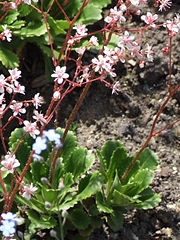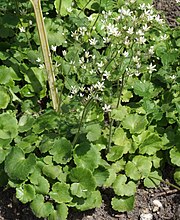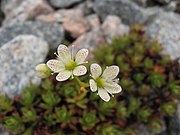Saxifraga
| Saxifraga subsp. var. | ||||||||||||||||||||||||||||||||||||||||||||||||||||||||
|---|---|---|---|---|---|---|---|---|---|---|---|---|---|---|---|---|---|---|---|---|---|---|---|---|---|---|---|---|---|---|---|---|---|---|---|---|---|---|---|---|---|---|---|---|---|---|---|---|---|---|---|---|---|---|---|---|

|
|
| ||||||||||||||||||||||||||||||||||||||||||||||||||||||
| ||||||||||||||||||||||||||||||||||||||||||||||||||||||||
Saxifraga is a genus containing about 440 known species of Holarctic perennial plants, making it the largest genus in the family Saxifragaceae. They are commonly called saxifrages or stone-breakers. The Latin word Saxifraga means literally "stone-breaker", from Latin saxum "rock" or "stone" + frangere "to break". This refers to certain saxifrages' ability to settle in the cracks of rocks, which they may in fact wear down by bioerosion to the point of splitting.
The genera Saxifragopsis (saxifragopsises), Saxifragella and the monotypic Chondrosea (Pyramidal Saxifrage) are sometimes included in Saxifraga.[1]
Most saxifrages are smallish plants whose leaves grow close to the ground, often in a rosette. The leaves typically have a more or less incised margin; they may be succulent, needle-like and/or hairy, reducing evaporation. Charles Darwin – erroneously believing Saxifraga to be allied to the sundew family (Droseraceae) – suspected the sticky-leaved Round-leaved Saxifrage (S. rotundifolia), Rue-leaved Saxifrage (S. tridactylites) and Pyrenean Saxifrage (S. umbrosa) to be protocarnivorous plants and conducted some experiments whose results supported his observations,[2] but the matter has apparently not been studied since his time.
The inflorescences or single flowers are raised above the main plant body at flowering time on stalks devoid of true leaves. The small actinomorphic hermaphrodite flowers have five petals and sepals and are usually white, but red to yellow in some species. As in other primitive eudicots, some of the 5 or 10 stamens may appear petal-like.
Saxifrages are typical inhabitants of arctic-alpine ecosystems, and are hardly ever found outside the temperate parts of the Northern Hemisphere; most members of this genus are found in subarctic climates. A good number of species grow in glacial habitat, such as S. biflora which can be found some 4,000 meters ASL in the Alps, or the East Greenland Saxifrage (S. nathorstii). The genus is also abundant in the Eastern and Western Himalayan alpine shrub and meadows. Though the archetypal saxifrage is a small plant huddling between rocks high up on a mountain, many species do not occur in such habitat and are larger (though still rather delicate) plants found on wet meadows.
Among those saxifrages found outside mountaineous, subarctic or glacial regions, Starry Saxifrage (S. stellaris) is often seen alongside Fountain Apple-moss (Philonotis fontana) at springs in Ireland, Britain, and other parts of Western Europe. In the same regions, Yellow Mountain Saxifrage (S. aizoides) is typically found in calcifugous grassland of the northern uplands together with Smooth Lady's-mantle (Alchemilla glabra), as well as (less abundantly) on upland calcicolous pastures characterized by Common Bent (Agrostis capillaris), Bendy Ditrichum moss (Ditrichum flexicaule), Sheep's Fescue (Festuca ovina) and Mother-of-Thyme (Thymus praecox). But it is also a common sight in acidic mires with rich growth of the sedge Carex demissa.
| Standard Cyclopedia of Horticulture |
|---|
|
Saxifraga (Latin, rock and to break; said by some to refer to the fact that many of the species grow in clefts of rock, by others to the supposition that certain species would cure stone in the bladder). Including Bergenia and Peltiphyllum, genera which are maintained as distinct by Engler in his last treatment of the group. Saxifragaceae. Saxifrage. Rockfoil. Chiefly perennial herbs, but a few species are annual and a few others biennial, while some others are subshrubby; useful for border planting, rockeries, and alpine gardens, and much prized by fanciers, particularly abroad. Plants usually with more or less developed caudicles which are either above or below ground: lvs. commonly clustered at the base and most often alternate on the sts., very variable in shape: infl. paniculate, corymbose, racemose or solitary: fls. as a rule not large, white, yellow, red, pink, or purple; calyx either free from or partly adnate to the base of the ovary, the tube short or elongated, 5-cleft or 5-parted; petals usually equal but occasionally decidedly unequal; stamens 10, rarely 5: fr. a 2-beaked, 2-celled caps. opening down or between the beaks, or sometimes 2 almost separate follicles; seeds numerous.—About 400 species from a horticultural viewpoint or approximately 250 botanically speaking. Temperate (principally alpine) and northern boreal regions, rare in Asia, very few in S. Amer. and lacking in Austral., S. Afr., and the Pacific islands. In preparing the following treatment of the genus and in the arrangement of species, Engler, in Engler & Prantl's Pflanzenfamilien, has been followed with the exception above mentioned, while the specific delimitation is largely based on Engler's Monographie der Gattung Saxifraga, 1872, with cultural and other horticultural information drawn from Irving & Malby's Saxifrages. The true saxifrages, so-called (excluding Bergenia and Peltiphyllum), have been separated into several genera at different times. The horticultural species mentioned in this treatment which are native of N. Amer. have been divided among the following genera: Saxifraga, Muscaria, Chondrosea, Micranthes, Spatularia, Leptasea, Heterisia, Peltiphyllum and Antiphylla. See Small in N. Amer. Fl., vol. 22, pt. 2, 1907. Saxifrages are various in habit and stature, but they are mostly low and spreading with rosulate or tufted root-leaves. Most of the species in cultivation are grown as rock-garden plants, although the large-leaved members of the Megasea or Bergenia section are sometimes used as border plants. Owing to the small attention given to rock- and alpine-gardening in America, the saxifrages are little known to our horticulturists. Most of them are abundantly hardy as to frost, but are likely to suffer from the dryness and heat of the American summer. Partial shade in summer is essential for the best results with most of the species. In winter the stools should be given ample covering of leaves. The most useful kinds for this country are the species of the Megasea section. These are low plants of bold habit, and are admirably adapted for rockwork and for spring forcing under glass. Fig. 1819, Vol. III, shows a clump of these plants in the lower left-hand comer. The alpine species are mostly dwarf plants with more or less persistent foliage. Many of them, as S. oppositifolia, make dense moss-like mats; others, of which S. Aizoon may be taken as a cultural type, produce a dense rosette of leaves at the surface of the ground, from which arises a flower-scape. Some of these forms are very interesting because of the vari-colored or silvery effect produced by natural incrustations of lime on the leaves, particularly on the leaf-edges. Give shade. Most saxifrages make stolons and offshoots freely, and by these the plants are easily propagated; they are also increased by division. Some make bulblets and multiply in this manner. The number of species of saxifrage cultivated abroad in rockeries and alpine-gardens is very large and there are many fanciers who have made very large collections of them. The following account has attempted to include those species which are in more general cultivation, although there are numerous others which occur in some of the collections, and it includes the better known hybrids and certain seedlings. A large part of these species are either very rare or lacking in American gardens. Very few of the species have been modified to any extent under domestication. S. atrovirens, Hort., is offered in the trade as a form growing 6 in. high, with white fls. Probably belongs in Section Dactyloides.—S. Bakeri, Hort., is one of the smaller mossy saxifrages with vivid green foliage, a plant of compact habit with rich carmine or rose fls. Probably belongs in Section Dactyloides.—S. Boykei, Hort., is offered in the trade.—S. capillaris, Hort., is offered in the trade as a white-fld. species. -S. carniolica, Hort., is offered in the trade and said to have white fls.—S. caryophylla, Hort., is offered in the trade as one of the easiest to grow, fls. white. Perhaps a misspelling of coriophylla, which is a variety of S. Rocheliana.—S. circuenta, Hort., is said to have silvery braided foliage and pretty little panicles of white fls. borne on sts. 4 in. high. It belongs to Section Euaizoonia.—S. cristata hybrida, Hort., is offered in the trade as a form growing 6 in. high, with white fls. Probably a form of S. Aizoon near var. paradoxa.—S. elatior, Mert. & Koch- S. Hostii.—S. elatior, of German authors – S. altissima.—S. elatior, Wimm.-S. Aizoon var. major.— S. Ganolini, Hort., is offered in the trade as growing 6 in. high with white fls.—S. Haworthii, Hort., forms cushions of rather pale green, about 6 in. high, the growth being packed and somewhat rounded at the top: fls. pure white and numerous. Probably belongs in Section Dactyloides.—S. Hectori, Hort., is offered in the trade.— S. hybrida, Hort., not others – S. decipiens.—S. hybrida, Haw.-.S. hypnoides.—S. incurvifolia, Hort., not Don, is listed as belonging to the encrusted section and as having white fls.—S. incurvifolia, Don, is a variety of S. cespitosa.—S. laevis, Hort.(?) of Bieb. and of Oettingen. The plant in cult. under this name belongs to Section Trachyphyllum and has a spreading habit like S. aizoides with loose rosettes of narrow elliptic-oval lvs.: fl.-sts. about 2 in. high, tinged crimson below and bearing each 4-6, not large, rich yellow fls. Caucasus. Requires a moist situation.—S. laevis, Bieb., also from Caucasus, is placed in Section Kabschia by Engler, but by several other authors is said to be close to S. Aizoon or S. aizoides and may be the same as the plant in cult.; if not the one now grown as S. laevis must receive a new name.—S. laevis, Oettingen, seems to be the same as that of Bieb. as far as the description is concerned; the plants have not been seen.—S. leans, Hort., is offered in the trade as a very compact form, 6 in. high, with white fls. Probably belongs in Section Dactyloides.—S. Lindesiana, Hort., also spelled Lindisiana, is offered in the trade as a mossy species with white fls. Perhaps belongs in Section Dactyloides.—S. lingueformis, Hort., is offered in the trade.—S. palmata, Hort., is uncertain and seems to be sometimes S. decipiens, sometimes S. geranioides. Var. foliis variegatis is a variety of one of these species with variegated foliage.—S. paradoxa, Hort., is described in a trade-list as a beautiful member of the Aizoon group with long and "braided" foliage. Presumably a natural hybrid between S. crustata and S. Hostii. Considered by some as a variety of S. Aizoon, which see.—S. paradoxa, Kit.-S. moschata var. pygmaea.—S. pectinata, Pursh-Luetkea pectinata, Kuntze.— S. pedatifida, Hort., is offered in the trade as a white-fld. species.—S. Pseudo-Fosteri, Hort., is offered in the trade as a hybrid of the encrusted section. Var. sancta, Hort., is offered in the trade as an early yellow-fld. form.—S. pyrolifolia, Don – Leptarrhena pyrolifolia. R. Br.—S. Ringeana, Hort.. is offered in the trade as a dwarf plant of spreading habit, growing 4 in. high and having white fls. Probably belongs in Section Dactyloides.—S. rupestris, Lapeyr.- S. ascendens.—S. rupestris, Salisb. – S. hypnoides. Which of these the material offered in the trade as a very compact plant growing 6 in. high, with white fls. cannot be determined with certainty, though probably the second as it is said to belong to the mossy section.—S. Schroederi, Hort., is offered in the trade as allied to S. ceratophylla which is a variety of S. trifurcata, a species of Section Dactyloides.—S. sexemifida, Hort., is offered in the trade. S. Sibthorpii, Boiss. Fig. 3558. Of the Cymbalaria group: perennial, cespitose, with reniform long-stalked obtuse- lobed lvs. and small yellowish fls.: petals ovate-elliptic. A good rock-plant, but seems not to be in the trade.—S. Stansfieldi, Wm. Robinson, is said to have a close-growing habit, dark green foliage and white fls. borne on sts. 4 in. high. Perhaps it belongs in Section Dactyloides.—S. stellata, Hort., not Pav., is offered in the trade as a white-fld. mossy plant, 1 ft. high. This is unquestionably not the stellata of Pavon which is the Peruvian representative of S. cespitosa and grows scarcely 1 in. high. —S. stenoglossa, Tausch. Lvs. of the rosette rather erect, cuneate or cuneate-linear, acute, serratures narrow, the lower ones spreading, the uppermost contiguous, with the terminal tooth slightly protruding. A plant is offered under this name, but whether the same as the indeterminable Tausch species it is impossible to say. The above given description is a translation of the original of Tausch.—S. Tantianae, Hort., is offered in the trade.—S. taxiophylla, Hort., is offered in the trade as a white-fld. species. Var. persifolia, Hort., is also offered.—S. tenuifolia, Hort., is offered in the trade as growing 6 in. high, with white fls. Probably belongs in Section Dactyloides.—S. Van Houttei, Hort., is offered in the trade. It belongs to Section Bergenia and has light pink fls.—S. venetica, Hort., is offered in the trade as a species with minute tufts and primrose-yellow fls. belonging in the encrusted section.—S. Webbiana, Hort., is offered in the trade. Possibly belongs in Section Dactyloides. CH
|
Cultivation
Propagation
Pests and diseases
Varieties
Ciliatae
Cotylea
Cymbalaria
Gymnopera (London Pride saxifrages)
Heterisia
Irregulares
Ligulatae (Silver saxifrages)
Merkianae
Mesogyne
Micranthes
Odontophyllae
Porphyrion
Saxifraga (Mossy saxifrages)
Trachyphyllum
Xanthizoon
Selected species:
Formerly placed here: Plants formerly placed in Saxifraga are mainly but not exclusively Saxifragaceae. They include:
- Astilboides tabularis, as S. tabularis
- Bergenia crassifolia, as S. cordifolia, S. crassifolia
- Bergenia pacumbis, as S. ligulata, S. pacumbis
- Bergenia purpurascens, as S. delavayi, S. purpurascens
- Boykinia jamesii, as S. jamesii
- Boykinia occidentalis (Coastal Brookfoam), as S. elata
- Boykinia richardsonii (Richardson's Brookfoam), as S. richardsonii
- Chondrosea cotyledon, as S. cotyledon
- Darmera peltata (Indian Rhubarb), as S. peltata
- Leptarrhena pyrolifolia, as S. pyrolifolia
- Luetkea pectinata (Partridgefoot), as S. pectinata
- Mukdenia rossii (Mukdenia), as S. rossii

Other "saxifragous" plants:
Several plant genera have names referring saxifrages although they might not be close relatives of Saxifraga. They include:
- Pyramidal Saxifrage, Chondrosea cotyledon
- Golden-saxifrages, Chrysosplenium
- Burnet-saxifrages, Pimpinella
- Pepper-saxifrage, Silaum silaus
Some plants refer Saxifraga in their generic or specific names, either because they are also "rock-breaking" or because they resemble members of the saxifrage genus:
- Campanula saxifraga
- Celmisia saxifraga (Benth.) W.M.Curtis
- Cineraria saxifraga DC.
- Dryopteris saxifraga
- Petrorhagia saxifraga – Tunicflower
- Pimpinella saxifraga – Burnet Saxifrage
- Ptychotis saxifraga
- Saxifragella
- Saxifragodes
- Saxifragopsis Small – saxifragopsises
Gallery
References
- Standard Cyclopedia of Horticulture, by L. H. Bailey, MacMillan Co., 1963
External links
- w:Saxifraga. Some of the material on this page may be from Wikipedia, under the Creative Commons license.
- Saxifraga QR Code (Size 50, 100, 200, 500)











